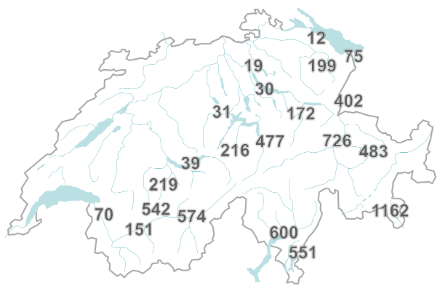Service Navigation
Search
In the Alps, the Valais is particularly prominent in terms of its frequent southerly foehn activity. The Montana and Visp weather stations recorded an average of 542 and 574 foehn hours per year respectively in the period of 1991–2020. This is significantly more than at the classic foehn site of Altdorf on the northern side of the Alps, where an average of 477 foehn hours per year has been recorded. The highest foehn frequency recorded in the Alps between 1991 and 2020 was at the Chur weather station in Graubünden, with an average of 726 foehn hours per year.
Considerable northern foehn activity can be observed on the southern slopes of the Alps. The Magadino and Lugano weather stations in southern Ticino recorded an average of 600 and 551 hours of foehn per year respectively during the 2007–2020 period for which data are available. The clear record holder for foehn is the Poschiavo weather station site in southern Graubünden, with an average of 1,162 foehn hours per year. This analysis is based on the 2008–2020 period for which data are available.
If these figures are converted to equivalent full days with 24 foehn hours, we can say that the foehn blew for 23 to 25 days per year in central Valais and southern Ticino. In Poschiavo, the foehn was present for more than 1.5 months per year, with an average of 48 full foehn days.

Annual cycle of southerly foehn
In the case of southerly foehn, the months of April and May have by far the highest foehn activity. This concentration can also be observed on the less foehn-prone Swiss plateau on the northern side of the Alps. A second, less pronounced concentration of foehn activity can be seen at some weather stations in the months of October and November. The Adelboden weather station in the Bernese Oberland is noteworthy, since there is no significant difference here between the frequency of foehn in spring and autumn.
At all weather stations recording a southerly foehn, the well-known foehn lull occurs in the summer months of June, July and August. At some weather stations, the foehn lull continues through to September. Foehn lulls also occur locally in the months of December and January, such as in Visp and Davos.
Annual cycle of the northerly foehn
On the southern side of the Alps, there is no obvious annual cycle with phases of foehn in spring and autumn. There is also no indication of a summertime lull in the foehn. At the Poschiavo weather station, the summer months of June and July actually tend to have more foehn. In the periods with foehn index from 2007 to 2020, the foehn peak on the southern side of the Alps occurred in March.
The Poschiavo weather station occupies a special position, not just because of its record-high foehn activity, but also because of the abrupt increase in foehn frequency from November to December and the continually active foehn months of December to May. In those months, Poschiavo experienced an average of 120 or more hours of foehn between 2008 and 2020. On the northern side of the Alps, it is only in April at the foehn-prone weather station of Chur that an average foehn frequency of 120 hours is seen.